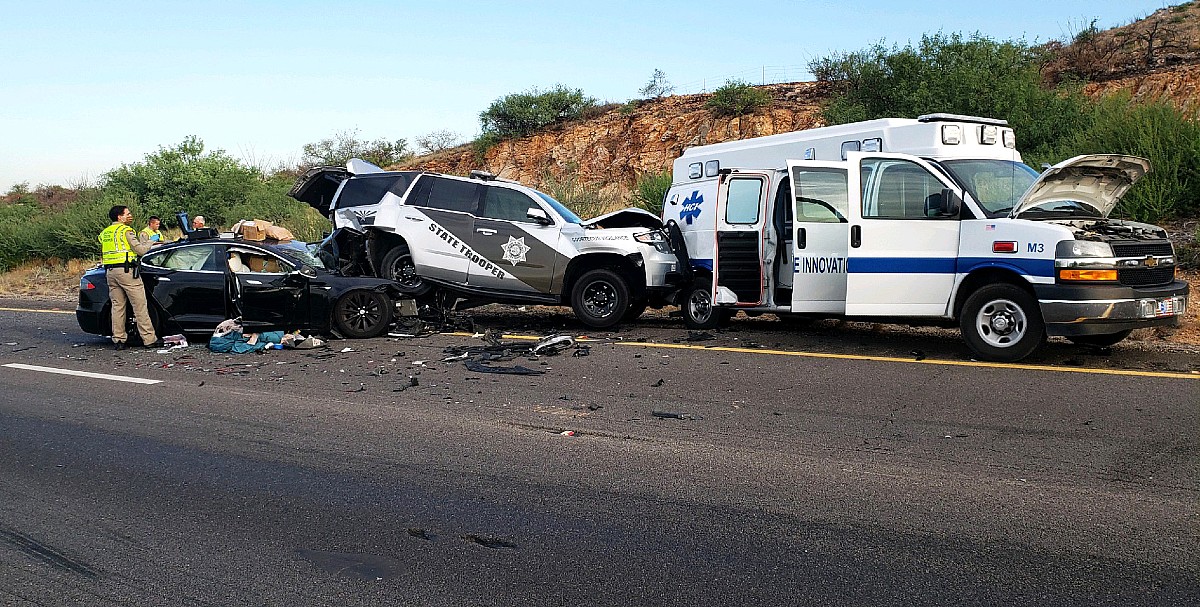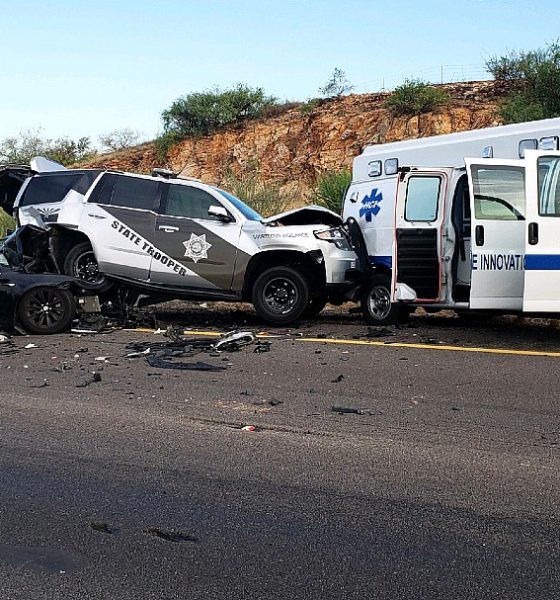

News
Tesla driver slams into State Police tending to another accident, DUI being investigated
The driver of a Tesla Model S crashed into the back of an Arizona State Trooper’s SUV on Tuesday after reportedly being under the influence. The driver told officers and deputies on the scene that he was using Tesla’s driving-assist Autopilot system.
The Trooper’s SUV then collided with an ambulance that was parked in front of the vehicle. The officer who was using the car was not in the vehicle at the time of the collision and was not injured.
The incident took place on Interstate 10 eastbound near Benson, Arizona, in the Southeastern portion of the state.
🚨 Reminder: Please #SlowDown & #MoveOver when you see flashing lights & vehicles stopped on the side of the road! Today, a Tesla rear-ended a patrol vehicle at the scene of an earlier crash on I-10 EB near Benson. Luckily, our sergeant wasn’t in the vehicle & wasn't hurt. (1/2) pic.twitter.com/WZhUQ10StL
— Dept. of Public Safety (@Arizona_DPS) July 14, 2020
The officer and ambulance involved in the crash were on the scene attending to victims from a previous collision, a member of the Arizona Department of Public Safety told Teslarati.
The driver of the Tesla seemingly did not move over to the right-hand lane when the SUV and Ambulance were parked on the left-hand shoulder.
In 2005, the State of Arizona passed the “Move Over” law, which required all drivers to shift lanes to protect police officers and emergency personnel from being subjected to vehicles passing at dangerous speeds.
At the current time, the driver of the Model S is in a Tucson, Arizona area hospital being treated for serious but non-life-threatening injuries. He has not been charged with anything at the current time, but is being investigated for Driving Under the Influence, an Arizona Department of Public Safety spokesperson said to Teslarati.
This is not the first time Tesla’s Autopilot has been under fire. In 2018, the National Highway Transportation Safety Administration (NHTSA) investigated an accident in Utah, where a driver who was using Autopilot in their Model S crashed into a parked firetruck at 60 MPH.
The driver walked away from the accident with a broken ankle, and NHTSA findings showed that she had not used Autopilot’s features responsibly. The steering wheel was unattended for 80 seconds, and the driver admitted to looking at her cell phone when the incident occurred.
Tesla maintains that using Autopilot still requires the attention of the driver at all times. Drivers are required to keep their hands on the steering wheel while using any of the company’s self-driving capabilities to ensure the safety of everyone on the road.
Autopilot has been blamed for accidents in the past. However, in many incidents, like the one in Utah, the company’s self-driving capability was vindicated based on NHTSA investigation findings. Tesla Autopilot remains one of the safest ways to navigate, as vehicles using the characteristic were involved in an accident once every 4.68 million miles driven, according to the company’s safety report. The national average is 479,000 miles.

News
Tesla FSD fleet is nearing 7 billion total miles, including 2.5 billion city miles
As can be seen on Tesla’s official FSD webpage, vehicles equipped with the system have now navigated over 6.99 billion miles.

Tesla’s Full Self-Driving (Supervised) fleet is closing in on almost 7 billion total miles driven, as per data posted by the company on its official FSD webpage.
These figures hint at the massive scale of data fueling Tesla’s rapid FSD improvements, which have been quite notable as of late.
FSD mileage milestones
As can be seen on Tesla’s official FSD webpage, vehicles equipped with the system have now navigated over 6.99 billion miles. Tesla owner and avid FSD tester Whole Mars Catalog also shared a screenshot indicating that from the nearly 7 billion miles traveled by the FSD fleet, more than 2.5 billion miles were driven inside cities.
City miles are particularly valuable for complex urban scenarios like unprotected turns, pedestrian interactions, and traffic lights. This is also the difference-maker for FSD, as only complex solutions, such as Waymo’s self-driving taxis, operate similarly on inner-city streets. And even then, incidents such as the San Francisco blackouts have proven challenging for sensor-rich vehicles like Waymos.
Tesla’s data edge
Tesla has a number of advantages in the autonomous vehicle sector, one of which is the size of its fleet and the number of vehicles training FSD on real-world roads. Tesla’s nearly 7 billion FSD miles then allow the company to roll out updates that make its vehicles behave like they are being driven by experienced drivers, even if they are operating on their own.
So notable are Tesla’s improvements to FSD that NVIDIA Director of Robotics Jim Fan, after experiencing FSD v14, noted that the system is the first AI that passes what he described as a “Physical Turing Test.”
“Despite knowing exactly how robot learning works, I still find it magical watching the steering wheel turn by itself. First it feels surreal, next it becomes routine. Then, like the smartphone, taking it away actively hurts. This is how humanity gets rewired and glued to god-like technologies,” Fan wrote in a post on X.
News
Tesla starts showing how FSD will change lives in Europe
Local officials tested the system on narrow country roads and were impressed by FSD’s smooth, human-like driving, with some calling the service a game-changer for everyday life in areas that are far from urban centers.

Tesla has launched Europe’s first public shuttle service using Full Self-Driving (Supervised) in the rural Eifelkreis Bitburg-Prüm region of Germany, demonstrating how the technology can restore independence and mobility for people who struggle with limited transport options.
Local officials tested the system on narrow country roads and were impressed by FSD’s smooth, human-like driving, with some calling the service a game-changer for everyday life in areas that are far from urban centers.
Officials see real impact on rural residents
Arzfeld Mayor Johannes Kuhl and District Administrator Andreas Kruppert personally tested the Tesla shuttle service. This allowed them to see just how well FSD navigated winding lanes and rural roads confidently. Kruppert said, “Autonomous driving sounds like science fiction to many, but we simply see here that it works totally well in rural regions too.” Kuhl, for his part, also noted that FSD “feels like a very experienced driver.”
The pilot complements the area’s “Citizen Bus” program, which provides on-demand rides for elderly residents who can no longer drive themselves. Tesla Europe shared a video of a demonstration of the service, highlighting how FSD gives people their freedom back, even in places where public transport is not as prevalent.
What the Ministry for Economic Affairs and Transport says
Rhineland-Palatinate’s Minister Daniela Schmitt supported the project, praising the collaboration that made this “first of its kind in Europe” possible. As per the ministry, the rural rollout for the service shows FSD’s potential beyond major cities, and it delivers tangible benefits like grocery runs, doctor visits, and social connections for isolated residents.
“Reliable and flexible mobility is especially vital in rural areas. With the launch of a shuttle service using self-driving vehicles (FSD supervised) by Tesla in the Eifelkreis Bitburg-Prüm, an innovative pilot project is now getting underway that complements local community bus services. It is the first project of its kind in Europe.
“The result is a real gain for rural mobility: greater accessibility, more flexibility and tangible benefits for everyday life. A strong signal for innovation, cooperation and future-oriented mobility beyond urban centers,” the ministry wrote in a LinkedIn post.
News
Tesla China quietly posts Robotaxi-related job listing
Tesla China is currently seeking a Low Voltage Electrical Engineer to work on circuit board design for the company’s autonomous vehicles.

Tesla has posted a new job listing in Shanghai explicitly tied to its Robotaxi program, fueling speculation that the company is preparing to launch its dedicated autonomous ride-hailing service in China.
As noted in the listing, Tesla China is currently seeking a Low Voltage Electrical Engineer to work on circuit board design for the company’s autonomous vehicles.
Robotaxi-specific role
The listing, which was shared on social media platform X by industry watcher @tslaming, suggested that Tesla China is looking to fill the role urgently. The job listing itself specifically mentions that the person hired for the role will be working on the Low Voltage Hardware team, which would design the circuit boards that would serve as the nervous system of the Robotaxi.
Key tasks for the role, as indicated in the job listing, include collaboration with PCB layout, firmware, mechanical, program management, and validation teams, among other responsibilities. The role is based in Shanghai.
China Robotaxi launch
China represents a massive potential market for robotaxis, with its dense urban centers and supportive policies in select cities. Tesla has limited permission to roll out FSD in the country, though despite this, its vehicles have been hailed as among the best in the market when it comes to autonomous features. So far, at least, it appears that China supports Tesla’s FSD and Robotaxi rollout.
This was hinted at in November, when Tesla brought the Cybercab to the 8th China International Import Expo (CIIE) in Shanghai, marking the first time that the autonomous two-seater was brought to the Asia-Pacific region. The vehicle, despite not having a release date in China, received a significant amount of interest among the event’s attendees.








